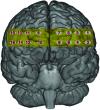Activation of the rostromedial prefrontal cortex during the experience of positive emotion in the context of esthetic experience. An fNIRS study
- PMID: 24391572
- PMCID: PMC3868912
- DOI: 10.3389/fnhum.2013.00879
Activation of the rostromedial prefrontal cortex during the experience of positive emotion in the context of esthetic experience. An fNIRS study
Abstract
The contemplation of visual art requires attention to be directed to external stimulus properties and internally generated thoughts. It has been proposed that the medial rostral prefrontal cortex (rPFC; BA10) plays a role in the maintenance of attention on external stimuli whereas the lateral area of the rPFC is associated with the preservation of attention on internal cognitions. An alternative hypothesis associates activation of medial rPFC with internal cognitions related to the self during emotion regulation. The aim of the current study was to differentiate activation within rPFC using functional near infrared spectroscopy (fNIRS) during the viewing of visual art selected to induce positive and negative valence, which were viewed under two conditions: (1) emotional introspection and (2) external object identification. Thirty participants (15 female) were recruited. Sixteen pre-rated images that represented either positive or negative valence were selected from an existing database of visual art. In one condition, participants were directed to engage in emotional introspection during picture viewing. The second condition involved a spot-the-difference task where participants compared two almost identical images, a viewing strategy that directed attention to external properties of the stimuli. The analysis revealed a significant increase of oxygenated blood in the medial rPFC during viewing of positive images compared to negative images. This finding suggests that the rPFC is involved during positive evaluations of visual art that may be related to judgment of pleasantness or attraction. The fNIRS data revealed no significant main effect between the two viewing conditions, which seemed to indicate that the emotional impact of the stimuli remained unaffected by the two viewing conditions.
Keywords: BA10; emotion; esthetics; fNIRS; prefrontal cortex.
Figures



Similar articles
-
Effects of self-directed and other-directed introspection and emotional valence on activation of the rostral prefrontal cortex during aesthetic experience.Neuropsychologia. 2015 May;71:38-45. doi: 10.1016/j.neuropsychologia.2015.03.013. Epub 2015 Mar 17. Neuropsychologia. 2015. PMID: 25791709
-
Prefrontal Brain Activation During Emotional Processing: A Functional Near Infrared Spectroscopy Study (fNIRS).Open Neuroimag J. 2011;5:33-9. doi: 10.2174/1874440001105010033. Epub 2011 May 11. Open Neuroimag J. 2011. PMID: 21673974 Free PMC article.
-
Brief Relaxation Practice Induces Significantly More Prefrontal Cortex Activation during Arithmetic Tasks Comparing to Viewing Greenery Images as Revealed by Functional Near-Infrared Spectroscopy (fNIRS).Int J Environ Res Public Health. 2020 Nov 12;17(22):8366. doi: 10.3390/ijerph17228366. Int J Environ Res Public Health. 2020. PMID: 33198147 Free PMC article. Clinical Trial.
-
Prefrontal activity measured by functional near infrared spectroscopy during probabilistic inference in subjects with persecutory delusions.Schizophr Res. 2015 Feb;161(2-3):237-43. doi: 10.1016/j.schres.2014.11.011. Epub 2014 Nov 29. Schizophr Res. 2015. PMID: 25439391
-
Does dorsolateral prefrontal cortex (DLPFC) activation return to baseline when sexual stimuli cease? The role of DLPFC in visual sexual stimulation.Neurosci Lett. 2007 Apr 6;416(1):55-60. doi: 10.1016/j.neulet.2007.01.058. Epub 2007 Jan 30. Neurosci Lett. 2007. PMID: 17316990
Cited by
-
fNIRS Evidence for Recognizably Different Positive Emotions.Front Hum Neurosci. 2019 Apr 9;13:120. doi: 10.3389/fnhum.2019.00120. eCollection 2019. Front Hum Neurosci. 2019. PMID: 31024278 Free PMC article.
-
Cerebrovascular Reactivity Measurement with Functional Near Infrared Spectroscopy.J Vis Exp. 2022 Jun 2;(184):10.3791/61284. doi: 10.3791/61284. J Vis Exp. 2022. PMID: 35723463 Free PMC article.
-
A Brief Review of Research Using Near-Infrared Spectroscopy to Measure Activation of the Prefrontal Cortex during Emotional Processing: The Importance of Experimental Design.Front Hum Neurosci. 2016 Oct 20;10:529. doi: 10.3389/fnhum.2016.00529. eCollection 2016. Front Hum Neurosci. 2016. PMID: 27812329 Free PMC article. Review.
-
Constituents of Music and Visual-Art Related Pleasure - A Critical Integrative Literature Review.Front Psychol. 2017 Jul 20;8:1218. doi: 10.3389/fpsyg.2017.01218. eCollection 2017. Front Psychol. 2017. PMID: 28775697 Free PMC article.
-
Near-infrared spectroscopy (NIRS) in functional research of prefrontal cortex.Front Hum Neurosci. 2015 May 12;9:274. doi: 10.3389/fnhum.2015.00274. eCollection 2015. Front Hum Neurosci. 2015. PMID: 26029090 Free PMC article. No abstract available.
References
-
- Burgess P. W., Dumontheil I., Gilbert S. J. (2005). “The gateway hypothesis of rostral prefrontal cortex (area 10) function,” in Measuring the Mind: Speed, Control and Age, eds Phillips D. L., McLeod P. (Oxford: Oxford University Press; ), 11, 217–2048 Retrieved from http://www.ncbi.nlm.nih.gov/pubmed/17548231
LinkOut - more resources
Full Text Sources
Other Literature Sources

